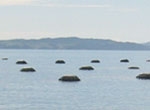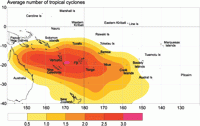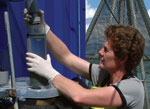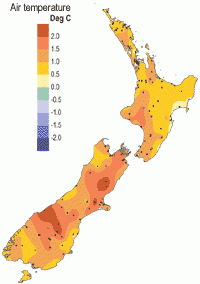PDF of this article (282 KB)





Scott Nodder, John Zeldis, Conrad Pilditch, Cliff Law, Kim Currie, and Hilke Giles have mapped and measured the muddy sediments of the Firth of Thames to uncover their contribution to the coastal ecosystem.
Ask anyone who has dived in the Firth of Thames and they will probably tell you that the place is nothing to write home about: visibility is limited and the seabed is muddy. However, the muddy sediments of the Firth seabed are exciting for those of us interested in the ecology of this seaway because they play a key role in determining the overall productivity of its waters.
The role of mud in coastal waters
Mud is a key player in the coastal ecosystem. In deep waters, re-suspended mud reduces the optical clarity of the water, affecting photosynthesis and primary production rates in planktonic algal communities. In shallower waters, where light penetrates to the sediment, microscopic algae that can fix light energy by photosynthesis live on the sediment surface. Mud also plays a role in nutrient cycling: the release of inorganic nutrients (such as nitrate, ammonium, and phosphate) out of muddy sediments into the water column by a host of biogeochemical processes stimulates planktonic productivity. (Some of these processes are described in 'More than just a crab hole')
It’s important to understand these processes so we can determine the natural bounds and resilience of the coastal ecosystem. This, in turn, will help us predict how the ecosystem responds when ’stressed' by human activities, such as fishing and aquaculture, and by pollution from the land. For the Firth of Thames, the Waihou River is an important local source of nutrients and sediments, and there are two large mussel farms already developed or proposed in its waters (see box below: Ecosystem effects of mussel aquaculture).
Mapping mud in the Firth of Thames
In December 2002 and December 2003, we went to the Firth of Thames to investigate the role of sediment and benthic processes in the productivity of a shallow-water ecosystem (less than 40 m deep). The first year we used SeaWorks' vessel Sea Surveyor for a pilot study to map sediment and water-column properties throughout the Firth, and to select representative sites for more intensive biogeochemical studies. These intensive studies were completed in the following summer onboard NIWA’s RV Kaharoa.
Results from the pilot study showed that there were obvious north-south gradients in sediment properties, as well as significant east-west trends, that let us divide the Firth into zones of broadly uniform characteristics for biogeochemical studies. While 'mud' was the dominant substrate, we found variations in the degree of 'muddiness', with 60-80% clay occurring at shallow sites at the southern end of the Firth and along its inner flanks, grading to shelly sandy sediments with 10-30% clay at the outer (northern) entrance to the Firth. Based on the sediments' grain-size and organic content, we selected seven sites for detailed measurements of benthic microalgal production, oxygen consumption by sediment communities, and nutrient and other gas fluxes. The dots on the map of the Firth show where we sampled; the seven stars indicate the more intensive sampling during the return visit in December 2003.
Measuring mud’s biogeochemistry
For the fieldwork in 2003, we adopted a standard sampling protocol at each site. Just before dawn, we collected water and ran salinity-temperature-depth profiles to determine water-column properties, and deployed a floating rig to measure in situ rates of primary production. Then, we used NIWA’s multi-corer to collect enough sediment cores for a series of shipboard incubations.
The sediment in these cores was extruded carefully into smaller chambers and placed in temperature-controlled incubation baths with both dark and light set-ups. During the incubations, we monitored dissolved-oxygen concentrations in the water in each chamber to determine the rate of oxygen consumption by organisms in the sediment. We injected replicate cores with isotopically enriched nitrate to study denitrification, a microbial process that converts dissolved nitrate into nitrogen gas. Nutrients (nitrate, ammonium, phosphate, silicate, dissolved organic and inorganic carbon) and nitrous oxide gas were sampled sequentially over the course of each incubation to determine fluxes across the sediment-water interface. The results of this campaign will help us calculate the importance of these nutrient transfers in supporting productivity in the coastal ecosystem.
A first for New Zealand
This was the first time that biogeochemical sampling has been undertaken at this level of detail in any New Zealand coastal area. We're expecting novel insights into how benthic communities and sediments contribute to the overall production and functioning of the Firth of Thames ecosystem. These data will be vital in building ecosystem models of the nutrient status and productive capacity of the Firth, and to understanding how the ecosystem is being affected by aquaculture and by land use in the surrounding catchments.
Ahhh, Firth of Thames mud – nothing quite like it for stirring the blood!
Clear as mud
- Sediments in coastal areas affect the amount of light available for photosynthesis and also how nutrients are cycled through the ecosystem.
- In a two-year project, scientists mapped the muddy sediments of the Firth of Thames.
- With detailed biogeochemical measurements of sediment cores, the scientists analysed how nutrients and nitrous oxide gas moved between the sediments and the water.
- This information has implications for keeping coastal waters healthy in areas of aquaculture and agriculture.
Ecosystem effects of mussel aquaculture

For her PhD research at the University of Waikato, Hilke Giles is examining the potential effects of mussel farms on nutrient dynamics in coastal ecosystems. In most coastal marine systems the rain of organic matter from the water column increases the activity of bacteria in the sediment that consume oxygen and release nutrients. In these shallow systems the water column is usually well mixed and the released nutrients therefore nourish the plankton and affect primary production.
Cultured mussels increase the rain of organic matter to the seabed by filtering particles from the water column and either rejecting them as pseudofaeces or excreting them as faeces. Pseudofaeces and faeces sink more readily than their constituent particles and are also of high nutritional value to benthic organisms.
For her fieldwork in the Firth of Thames, Hilke used benthic chambers to investigate the seasonal changes in benthic activity and nutrient regeneration rates under a mussel farm and at a nearby control site. By measuring the change of oxygen and nutrient concentrations inside the chambers over time, she calculated their fluxes from the sediment. She found that sediment oxygen consumption is significantly higher under the farm than at the control site and increases with increasing water temperature. Nutrient release rates are also generally higher under the farm. These results reinforce the idea that sediments under mussel farms are important sites for nutrient regeneration, and that mussel farms can significantly alter the nutrient dynamics in coastal ecosystems.
NIWA collaborated with the University of Waikato for this project. Dr Scott Nodder (sediment dynamics) and Dr Cliff Law (ocean-atmosphere) are based at NIWA in Wellington; Dr John Zeldis (marine ecosystems and aquaculture) is at NIWA in Christchurch; Dr Kim Currie (ocean atmosphere) is with the NIWA Centre of Physical and Chemical Oceanography at the University of Otago. Dr Conrad Pilditch and Hilke Giles are with the School of Biological Sciences at the University of Waikato. Technical support was provided by Peter Gerring and Lisa Northcote from NIWA.
The authors thank officers and crew of the Sea Surveyor and RV Kaharoa, NIWA Vessels Management, and NIWA staff Mark Gall, Malcolm Greig, Matt Walkington, and Kay Vopel. Thanks also to the Group A Wilson’s Bay Marine Farming Consortium and Dean and Mark Aislabe at Waimangu Point for supporting this work. Funding was provided by FRST as part of the 'Ocean Ecosystems' programme.
Author contact: [email protected]
Teachers’ resource for NCEA AS: Biology 90461 (2.5), 90718 (3.6); Science 90772 (2.3). See other curriculum connections at www.niwa.co.nz/pubs/wa/resources
